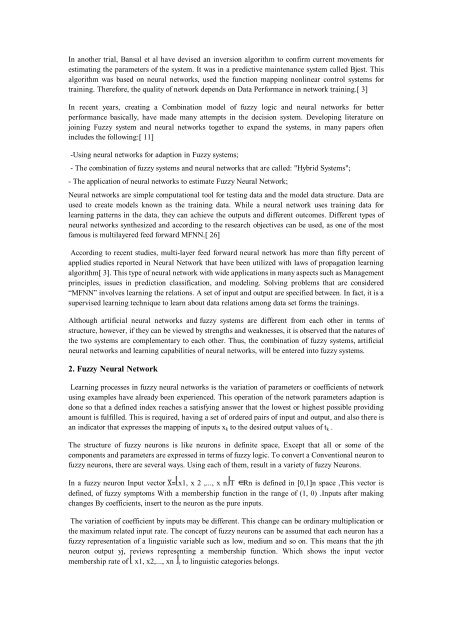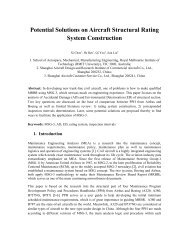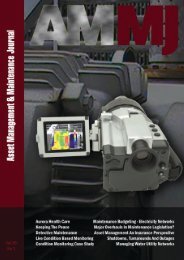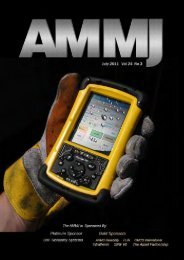Predictive Maintenance Planning With Fuzzy Neural ... - AMMJ
Predictive Maintenance Planning With Fuzzy Neural ... - AMMJ
Predictive Maintenance Planning With Fuzzy Neural ... - AMMJ
- No tags were found...
Create successful ePaper yourself
Turn your PDF publications into a flip-book with our unique Google optimized e-Paper software.
In another trial, Bansal et al have devised an inversion algorithm to confirm current movements forestimating the parameters of the system. It was in a predictive maintenance system called Bjest. Thisalgorithm was based on neural networks, used the function mapping nonlinear control systems fortraining. Therefore, the quality of network depends on Data Performance in network training. [ 3]In recent years, creating a Combination model of fuzzy logic and neural networks for betterperformance basically, have made many attempts in the decision system. Developing literature onjoining <strong>Fuzzy</strong> system and neural networks together to expand the systems, in many papers oftenincludes the following: [ 11]-Using neural networks for adaption in <strong>Fuzzy</strong> systems;- The combination of fuzzy systems and neural networks that are called: "Hybrid Systems";- The application of neural networks to estimate <strong>Fuzzy</strong> <strong>Neural</strong> Network;<strong>Neural</strong> networks are simple computational tool for testing data and the model data structure. Data areused to create models known as the training data. While a neural network uses training data forlearning patterns in the data, they can achieve the outputs and different outcomes. Different types ofneural networks synthesized and according to the research objectives can be used, as one of the mostfamous is multilayered feed forward MFNN. [ 26]According to recent studies, multi-layer feed forward neural network has more than fifty percent ofapplied studies reported in <strong>Neural</strong> Network that have been utilized with laws of propagation learningalgorithm [ 3]. This type of neural network with wide applications in many aspects such as Managementprinciples, issues in prediction classification, and modeling. Solving problems that are considered“MFNN” involves learning the relations. A set of input and output are specified between. In fact, it is asupervised learning technique to learn about data relations among data set forms the trainings.Although artificial neural networks and fuzzy systems are different from each other in terms ofstructure, however, if they can be viewed by strengths and weaknesses, it is observed that the natures ofthe two systems are complementary to each other. Thus, the combination of fuzzy systems, artificialneural networks and learning capabilities of neural networks, will be entered into fuzzy systems.2. <strong>Fuzzy</strong> <strong>Neural</strong> NetworkLearning processes in fuzzy neural networks is the variation of parameters or coefficients of networkusing examples have already been experienced. This operation of the network parameters adaption isdone so that a defined index reaches a satisfying answer that the lowest or highest possible providingamount is fulfilled. This is required, having a set of ordered pairs of input and output, and also there isan indicator that expresses the mapping of inputs x k to the desired output values of t k .The structure of fuzzy neurons is like neurons in definite space, Except that all or some of thecomponents and parameters are expressed in terms of fuzzy logic. To convert a Conventional neuron tofuzzy neurons, there are several ways. Using each of them, result in a variety of fuzzy Neurons.In a fuzzy neuron Input vector X=⎣x1, x 2 ,..., x n⎦T ∈Rn is defined in [0,1]n space ,This vector isdefined, of fuzzy symptoms <strong>With</strong> a membership function in the range of (1, 0) .Inputs after makingchanges By coefficients, insert to the neuron as the pure inputs.The variation of coefficient by inputs may be different. This change can be ordinary multiplication orthe maximum related input rate. The concept of fuzzy neurons can be assumed that each neuron has afuzzy representation of a linguistic variable such as low, medium and so on. This means that the jthneuron output yj, reviews representing a membership function. Which shows the input vectormembership rate of ⎣ x1, x2,..., xn ⎦ r to linguistic categories belongs.












